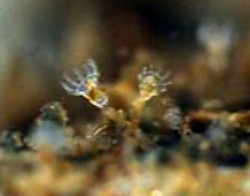Description
Taxonomy - Mariscal's specimens from San Francisco Bay, identified as Barentsia gracilis, were synonymised by Wasson (1997a) with B. benedeni.
Taxonomy
| Kingdom | Phylum | Class | Order | Family | Genus |
|---|---|---|---|---|---|
| Animalia | Entoprocta (Kamptozoa) | None | Coloniales | Barentsiidae | Barentsia |
Synonyms
Invasion History
Chesapeake Bay Status
| First Record | Population | Range | Introduction | Residency | Source Region | Native Region | Vectors |
|---|---|---|---|---|---|---|---|
| 1994 | Established | Expanding | Introduced | Regular Resident | Unknown-Marine | Unknown-Marine | Shipping(Fouling Community) |
History of Spread
The entoproct (or kamptozoan) Barentsia benedeni was described from Ostende, Belgium in 1887, but its origin is unknown. It was found to be widespread in European waters, from the Baltic to the Mediterranean, Black and Caspian Seas, and later found on the coasts Japan of Japan, Australia, and the Pacific coast of North America (Nielsen 1989; Wasson 1997a). Because of this organism's small size, and the scarcity of people with taxonomic knowledge of this group, Barentsia benedeni is likely to be overlooked at many sites, and not recorded until long after its invasion.
On the U.S. Pacific coast, B. benedeni was first found in Lake Merritt, San Francsico Bay in 1929 (Cohen and Carlton 1995; Wasson 1997), and subsequently in Coos Bay OR in 1988 (Carlton 1989), and Puget Sound WA in 1998 (Cohen et al. 1998).
On the East Coast, Barentsia benedeni was collected in Vineyard Haven, Martha's Vineyard MA in 1977 (Jebram and Everitt 1982), and also reported from 'Cape Cod' (possibly referring to the Martha's Vineyard record) (Nielsen 1989). It was not collected in previous studies of entoprocts in the Chesapeake Bay (Osburn 1944) or other East Coast sites (Woods Hole MA, NC, SC) (Wasson et al. 2000).
In the Chesapeake Bay, B. benedeni was first identified on settling plates in 1994, in sites in upper and lower Chesapeake Bay. In 1994-1996, it was collected in Baltimore Harbor and the Severn River, in Mobjack Bay, and Norfolk harbor (Wasson et al. 2000).
History References- Jebram and Everitt 1982; Carlton 1989; Cohen and Carlton 1995; Wasson 1997a; Cohen et al. 1998; Wasson et al. 2000
Invasion Comments
Ecology
Environmental Tolerances
| For Survival | For Reproduction | |||
|---|---|---|---|---|
| Minimum | Maximum | Minimum | Maximum | |
| Temperature (ºC) | 5.0 | 30.0 | ||
| Salinity (‰) | 7.0 | 35.0 | ||
| Oxygen | ||||
| pH | ||||
| Salinity Range | meso-poly |
Age and Growth
| Male | Female | |
|---|---|---|
| Minimum Adult Size (mm) | 0.7 | 0.7 |
| Typical Adult Size (mm) | 4.5 | 4.5 |
| Maximum Adult Size (mm) | 8.5 | 8.5 |
| Maximum Longevity (yrs) | ||
| Typical Longevity (yrs |
Reproduction
| Start | Peak | End | |
|---|---|---|---|
| Reproductive Season | |||
| Typical Number of Young Per Reproductive Event |
|||
| Sexuality Mode(s) | |||
| Mode(s) of Asexual Reproduction |
|||
| Fertilization Type(s) | |||
| More than One Reproduction Event per Year |
|||
| Reproductive Startegy | |||
| Egg/Seed Form |
Impacts
Economic Impacts in Chesapeake Bay
Although it is an abundant fouling organism in Chesapeake Bay, because of its small size, Barentsia benedeni has no economic importance in the Chesapeake Bay region.
Economic Impacts Outside of Chesapeake Bay
Although it is an abundant and widespread fouling organism, because of its small size, Barentsia benedeni has no reported economic importance
Ecological Impacts on Chesapeake Native Species
Effects of Barentsia benedeni on native biota are unknown for Chesapeake Bay and elsewhere. However, it is striking that during the SERC Invasions Group settling plate surveys, none of the native entoproct species reported by Osburn (1944) from the Bay were found. Many of his collections were made in Atlantic Coastal bays, where setling plates have not been deployed. However, it is possible that the native species have been replaced by the introduced entoprocts (Wasson et al. 2000).
References - Cohen and Carlton 1995; Ruiz et al. unpublished; Wasson 1997; Wasson et al. 2000
Ecological Impacts on Other Chesapeake Non-Native Species
Effects of Barentsia benedeni on exotic biota are unknown for Chesapeake Bay and elsewhere.
References
Carlton, James T. (1989) Man's role in changing the face of the ocean: biological invasions and implications for conservation of near-shore environments, Conservation Biology 3: 265-273Cohen, Andrew N.; Carlton, James T. (1995) Nonindigenous aquatic species in a United States estuary: a case study of the biological invasions of the San Francisco Bay and Delta, , Washington DC, Silver Spring MD.. Pp.
Jebram, Diethardt; Everitt, Betty (1982) New victorellids (Bryozoa, Ctenostomata) from North America: the use of parallel cultures in bryozoan taxonomy., Biological Bulletin 163: 172-187
Mariscal, Richard N. (1965) The adult and larval morphology and life history of the entoproct Barentsia gracilis (M. Sars, 1935)., Journal of Morphology 116: 311-338
Nielsen, Claus (1989) Entoprocts, , Leiden. Pp.
Osburn, Raymond C. (1944) A survey of the Bryozoa of Chesapeake Bay, Chesapeake Biological Laboratory Publications 63: 1-55
Resource Management Inc. (1993) National list of plant species that occur in wetlands., , Minneapolis.. Pp.
Ritchie, J. (1911) On an Entoproctan Polyzoon (Barentsia benedeni) new to the British Fauna, with remarks on Related Species., Transactions of the Royal Society of Edinburgh 47: 835-848
Wasson, Kerstin (1997) Systematic revision of colonial kamptozoans (entoprocts) of the Pacific coast of North America, Zoological Journal of the Linnean Society 121: 1-63
Wasson, Kerstin (1997) Sexual modes in the colonial Kamptozoan genus Barentsia, Biological Bulletin 193: 163-170
Wasson, Kerstin; Toft, Jason; Von Holle, Betsy; Ruiz, Gregory (2000) Detecting invasions of marine organisms: kamptozoan case histories., Biological Invasions 2: 59-74
